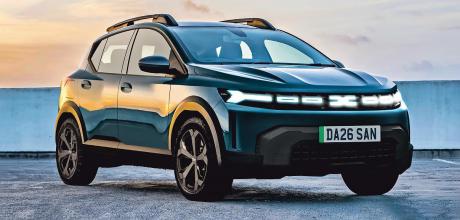Dacia Sandero to be reborn as rugged EV
Top-selling hatch will become a high-riding ‘active’ car with electric power in 2027
T he Dacia Sandero will be reinvented for its fourth generation as a rugged, raised supermini with pure-electric power – but it will stay true to the affordable billing that has made it one of Europe’s most popular cars. Company CEO Denis Le Vot revealed the new Sandero will arrive in “2027 or 2028”, “live until 2034 or 2035” and serve as a flag-bearer for the marque’s low-cost route to a zero-emissions line-up.
Once the new Duster is launched in 2024, every Dacia (except the Spring) will be based on the Renault Group’s CMF-B platform, and its EVs will follow suit by moving onto the closely related CMF-BEV electric equivalent. This means the electric Sandero will effectively be Dacia’s take on the Renault 5, albeit with a more overt focus on utility and practicality – and company bosses have hinted it will build on the formula for the popular Sandero Stepway in adopting an element of ruggedness and off-road usability.
Le Vot explained that for it to remain one of the most affordable cars in its segment, it will need to go without the headline-baiting EV performance stats of upcoming rivals. “We will go for a shorter range and longer charge times” than electric rivals in the B-segment, he said, because “we want a cheaper price for the customer”.
He pointed to the increasing entry price of mainstream electric cars – “€35,000, €40,000, €45,000” – as an inhibitor to widespread uptake and laid bare Dacia’s commitment to providing a more accessible alternative. Minimising weight will be key to keeping costs down and could even prompt Dacia to fit a smaller battery than that destined for the Sandero’s platform siblings. Le Vot said Dacia will not target a “500-600km [311-373-mile] range and 20-minute charging”.
He added that the firm is investigating ways to make the battery chemistry as cheap as possible too. “Maybe the battery will be sodium-based,” he said. “Some argue sodium batteries aren’t great because they don’t store a lot of energy and they are heavy. But they’re cheap.” Design boss David Durand gave clues about how the next Sandero will fit into the brand’s new-look line-up and be substantially differentiated from the current car, but he suggested it will remain recognisable as a hatchback because Dacia is not targeting an all-SUV range.
He said: “It’s more that you have a car that you can use in any condition; you’re not afraid to damage if you’re on a bad road; you have enough ground clearance to avoid having to say ‘I’m going to crush the bottom of my car – I can’t go there’ or ‘the branches are going to scratch the doors – I’m not going there’.”
Based on this outlook, it stands to reason that the next Sandero will sit higher off the ground than the current car and be designed to more overtly showcase Dacia’s new active ethos.
Sales and marketing boss Xavier Martinet suggested Dacia will build on this utilitarian, outdoors-focused positioning with future models: “What’s the customer promise you’re getting with your car? The 4x4 ability of the Duster, or I would even say the Sandero Stepway, which adds a higher ground clearance and the capability to go outside of normal roads. It’s something that customers value a lot.”
High demand for the plasticclad, higher-riding Stepway variant (Martinet said “we’re selling more than 70% of our vehicles in the top trim level”) could mean the next car will gain these attributes as standard.
An ICE Mk4 Sandero remains possible, given that such cars can be sold until 2035 in the EU (2030 in the UK), but no doubt this will come with the hybrid tech recently introduced in the Jogger.
Mk4 Sandero will expand on ethos of today’s Stepway


